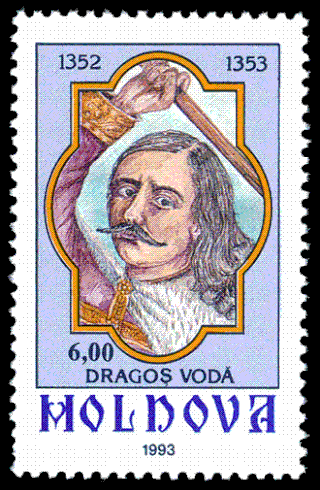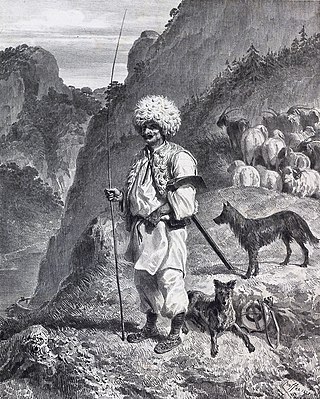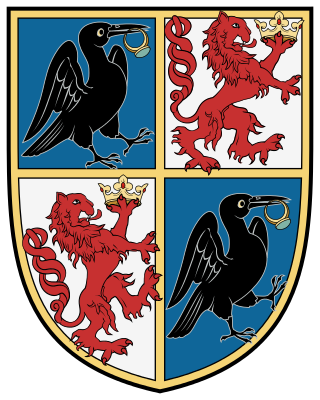Related Research Articles
Litovoi, also Litvoy, was a Vlach/Romanian voivode in the 13th century whose territory comprised northern Oltenia in today's Romania.
The Transylvanian peasant revolt, also known as the peasant revolt of Bábolna or Bobâlna revolt, was a popular revolt in the eastern territories of the Kingdom of Hungary in 1437. The revolt broke out after George Lépes, bishop of Transylvania, had failed to collect the tithe for years because of a temporary debasement of the coinage, but then demanded the arrears in one sum when coins of higher value were again issued. Most commoners were unable to pay the demanded sum, but the bishop did not renounce his claim and applied interdict and other ecclesiastic penalties to enforce the payment.

Dragoș, also known as Dragoș Vodă, or Dragoș the Founder was the first Voivode of Moldavia, who reigned in the middle of the 14th century, according to the earliest Moldavian chronicles. The same sources say that Dragoș came from Maramureş while chasing an aurochs or zimbru across the Carpathian Mountains. His descălecat, or "dismounting", on the banks of the Moldova River has traditionally been regarded as the symbol of the foundation of the Principality of Moldavia in Romanian historiography. Most details of his life are uncertain. Historians have identified him either with Dragoș of Bedeu or with Dragoș of Giulești, who were Vlach landowners in the Kingdom of Hungary.

Bogdan I, or Bogdan the Founder, was the first independent ruler, or voivode, of Moldavia in the 1360s. He had initially been the voivode, or head, of the Vlachs in the Voivodeship of Maramureș in the Kingdom of Hungary. However, when the first certain record was made of him in 1343, he was mentioned as a former voivode who had become disloyal to Louis I of Hungary. He invaded the domains of a Vlach landowner who remained loyal to the king in 1349. Four years later, he was again mentioned as voivode in a charter, which was the last record of his presence in Maramureș.
The Prince of Transylvania was the head of state of the Principality of Transylvania from the last decades of the 16th century until the middle of the 18th century. John Sigismund Zápolya was the first to adopt the title in 1570, but its use only became stable from 1576.
Universitas Valachorum is the Latin denomination for an estate, an institution of self-government of the Romanians in medieval Transylvania, which then belonged to the Kingdom of Hungary.

The Vlach law refers to the traditional Romanian common law as well as to various special laws and privileges enjoyed or enforced upon particularly pastoralist communities of Romanian stock or origin in European states of the Late Middle Ages and Early modern period, including in the two Romanian polities of Moldavia and Wallachia, as well as in the Kingdom of Hungary, the Kingdom of Poland, Kingdom of Serbia, the Polish–Lithuanian Commonwealth, etc.

The Hunyadi family was one of the most powerful noble families in the Kingdom of Hungary during the 15th century. A member of the family, Matthias Corvinus, was King of Hungary from 1458 until 1490, King of Bohemia from 1469 until 1490, and Duke of Austria from 1487 until 1490. His illegitimate son, John Corvinus, ruled the Duchy of Troppau from 1485 until 1501, and five further Silesian duchies, including Bytom, Głubczyce, Loslau, Racibórz, and Tost, from 1485 until 1490. The Hunyadi coat-of-arms depicted a raven with a golden ring in its beak.

The Voivode of Transylvania was the highest-ranking official in Transylvania within the Kingdom of Hungary from the 12th century to the 16th century. Appointed by the monarchs, the voivodes – themselves also the heads or ispáns of Fehér County – were the superiors of the ispáns of all the other counties in the province.
Farcaș, also Farkas, Farkaș or Farcas, was a cneaz mentioned in the Diploma of the Joannites issued by king Béla IV of Hungary (1235–1270) on 2 July 1247; the diploma granted territories to the Knights Hospitaller in the Banate of Severin and Cumania. Farcaş held a kenazate which was given to the knights by the king. His kenazate lay in the northeast of modern Oltenia.

The Transylvanian Diet was an important legislative, administrative and judicial body of the Principality of Transylvania between 1570 and 1867. The general assemblies of the Transylvanian noblemen and the joint assemblies of the representatives of the "Three Nations of Transylvania"—the noblemen, Székelys and Saxons—gave rise to its development. After the disintegration of the medieval Kingdom of Hungary in 1541, delegates from the counties of the eastern and northeastern territories of Hungary proper also attained the Transylvanian Diet, transforming it into a legal successor of the medieval Diets of Hungary.

The Banate of Severin or Banate of Szörény was a Hungarian political, military and administrative unit with a special role in the initially anti-Bulgarian, latterly anti-Ottoman defensive system of the medieval Kingdom of Hungary. It was founded by Prince Béla in 1228.

The Count of the Székelys was the leader of the Hungarian-speaking Székelys in Transylvania, in the medieval Kingdom of Hungary. First mentioned in royal charters of the 13th century, the counts were the highest-ranking royal officials in Székely Land. From around 1320 to the second half of the 15th century, the counts' jurisdiction included four Transylvanian Saxon districts, in addition to the seven Székely seats.

The Duke of Transylvania was a title of nobility four times granted to a son or a brother of the Hungarian monarch. The dukes of the first and second creations, Béla (1226–1235) and Stephen of the Árpád dynasty were in fact viceroys with significant authority in Transylvania. The duke of the third creation, Louis, did not administer the province. The fourth duke, Stephen of the Anjou dynasty (1350–1351) did not play any significant role in politics.

A conditional noble or predialist was a landowner in the Kingdom of Hungary who was obliged to render specific services to his lord in return for his landholding, in contrast with a "true nobleman of the realm" who held his estates free of such services. Most conditional nobles lived in the border territories of the kingdom, including Slavonia and Transylvania, but some of their groups possessed lands in estates of Roman Catholic prelates. Certain groups of conditional nobility, including the "ecclesiastic nobles" and the "nobles of Turopolje" preserved their specific status until the 19th century.
A Romanian district was an autonomous administrative unit of the Vlachs in the medieval Kingdom of Hungary.
A knez or kenez was a leader of the Vlach (Romanian) communities in the Kingdom of Hungary and western Balkans, during the Middle Ages.
The boyars of Fogaras were a group of Vlach conditional nobles in the medieval Kingdom of Hungary and the Principality of Transylvania.
The Voivodeship of Maramureș, was a Romanian voivodeship centered in the region of the same name within the Kingdom of Hungary. It was the most powerful and well-organized Romanian entity in the broader area of Transylvania during the 14th century. The Voivodeship of Maramureș was established in 1343. It was ultimately disestablished and supplanted with the Hungarian Máramaros County.
References
- ↑ Miloš Luković: Zakon Vlachom (Jus Valachicum) in the Charters Issued to Serbian Medieval Monasteries and Kanuns Regarding Vlachs in the Early Ottoman Tax Register, 2015, page 36
- ↑ Bónis 2003, pp. 275–276.
- ↑ Nägler 2005, p. 230.
- ↑ Makkai 1994, pp. 196–197.
- ↑ Dragomir, Silviu (1924). Originea coloniilor române din Istria][Origin of Romanian Colonies in Istria]. Cultura Națională. pp. 3–4, .
- ↑ Ioan Bogdan: Originea voivodatului la români (The Origin of Romanian Voievodeship), page 195
- ↑ Ioan Bogdan: Originea voievodatului la români (The Origin of Romanian Voievodeship), page 195
- ↑ Ioan Bogdan: Originea voievodatului la români (The Origin of Romanian Voievodeship), page 198